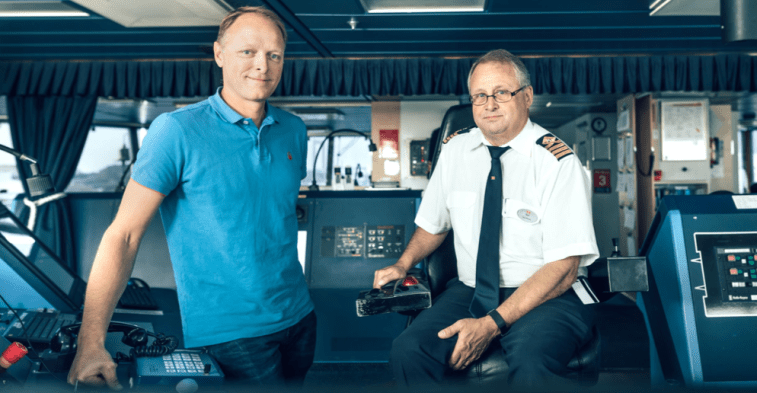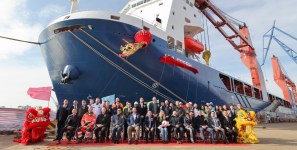ARTIFICIAL INTELLIGENCE AND OTHER INNOVATIONS ARE FOREVER CHANGING LARGE VESSELS
Throughout the course of human history, civilizations have relied on transit across water to travel, trade and invade. Archaeologists can trace the use of boats back many thousands of years, with circumstantial evidence pointing toward their use as early as 9,500 BC, well before the Pesse canoe, commonly thought to represent the world’s oldest known boat.
Navigational knowledge and boatbuilding techniques have advanced steadily over time; the enormous ships we see transporting people and goods today are extraordinary evolutions of their ancestors.
In the container ship realm, it was not until the 1950s that the first commercially successful vessel completed its maiden voyage. Named Ideal X, it was a T2 tanker owned by Malcom McClean that carried 58 containers between Newark, New Jersey, and Houston. By contrast, today’s largest container ship, the HMM Algeciras, can carry up to 24,000 TEUs.
Shipping is, quite literally, big business. In monetary terms, the $900 billion shipping logistics industry is expected to be valued at more than $2 trillion by 2023, growth underpinned by increasingly efficient vessels that make use of cutting-edge innovations.
For instance, by 2025 the global market for electric-powered shipping vessels is set to be worth $8.4 billion, rising to $15.6 billion come the end of the decade.
Meanwhile, the demand for maritime data analytics is set to increase from $895 million in 2019 to more than $1.8 billion by 2027. Wherever you look, technology is steering the value of big ships upwards.
Artificial intelligence – an unstoppable tide?
One strand of technological innovation in ships that is making waves is artificial intelligence (AI).
Defined as the ability of a machine or a robot controlled by a computer to do tasks that are usually done by humans because they require human intelligence and discernment, AI is taking on an increasing number of use cases aboard large vessels.
Fuel is one of the largest costs for shipping companies. For Swedish shipping giant Stena Line, it constitutes a massive 20 percent of all running costs. Innovation to help cut fuel consumption has therefore become a major priority.
Stena, which is also one of the world’s largest ferry operators, has been experimenting with the use of AI technology on one of its vessels as it travels overnight from Gothenburg to the German Port of Kiel.
Working in collaboration with Hitachi, the Stena Fuel Pilot can predict the most fuel-efficient way to operate a vessel and assist the onboard captain and crew to lower the fuel consumption. The results from Stena Scandinavica show a reduced fuel consumption of 2-3 percent per trip, results which have prompted Stena to deploy the AI assistant across its entire fleet of 37 ships.
Niklas Kapare, captain on M/S Skåne, has used the technology first-hand. He commented: “We can see that it is working, even though we need to continue to adjust it to improve the results. As a captain, I get a good overview of several factors such as wind, currents and squat, and assistance to use the right power and number of engines to lower the fuel consumption.”
Another important use case for AI aboard vessels is navigation. Using sophisticated tracking software in tandem with IoT connectivity, these systems can be leveraged to analyze multiple navigational scenarios.
Stena is, once again, leading the way in this regard through its AI Captain solution. It is capable of recalculating routes during voyages when it receives information to suggest that problems may lie ahead. Such problems could be in the immediate distance, and it is here that AI-powered image recognition technology has a role to play.
An example of this in action is a collaboration between Chinese tech firm SenseTime and Japanese shipping company Mitsui OSK Lines. SenseTime’s system leverages ultra-high-resolution cameras and a graphic processing unit to automatically identify vessels in a ship’s surrounding area, designed to prevent large vessels such as container ships and cruise liners from colliding with smaller ones. The solution can also alert crew to other hazards when visibility is poor.
It is not just aboard ships that AI can have an impact, however. The industry could also benefit from slicker terminal operations, with AI being trialed in a number of areas such as container handling, decking systems, gate volume predictions and vessel stowage.
According to a study from Navis toward the end of 2019, 88 percent of respondents indicated that automated decision-making will be very, if not extremely, important for the future of innovation at terminals.
Andy Barrons, chief strategy officer at Navis, said at the time: “Just a few short years ago, only a handful of our customers were even open to the idea of automation or other disruptive technologies designed to make the container terminal smarter, safer and more sustainable.
“The survey demonstrates just how far the industry has come–and will continue to go–in harnessing technology in the right ways to automate decision making within terminals. We firmly believe that automation and the use of AI is our future, and will continue to support our current and future customers as they embark down this critical path.”
A fully autonomous future?
But just how far will AI technology embed itself into the workings of ships and the wider industry?
It is a mightily difficult question to answer, but there are signs that we are only just at the beginning of AI’s shipping industry voyage.
Yara Birkeland is an emission-free and fully autonomous 120 TEU container ship that is under construction and due to be launched imminently. At the end of November 2020, the ship was handed over to Yara from the Norwegian shipyard Vard Brattvåg, where it is undergoing testing for container loading and stability before being sailed to a port and test area in Horten for further preparations.
Elsewhere, the European Union through its Horizon 2020 Research and Innovation program is funding a three-year project aimed at creating trade lanes linked by automated port services and used by autonomous ships.
The Advanced, Efficient and Green Intermodal Systems (AEGIS) initiative is expected to complete in May 2023 and is in line with the EU’s plans to accelerate efforts to shift road transport volumes to rail and waterborne transport. Although the project is targeting smaller ships and short-sea operations, the wider implications could be momentous if it is deemed a successful endeavor.
However, one of the stumbling blocks in relation to automated ships is cost.
The enormity of the technology required (at least at present) means that many ship operators, especially those with large vessels, will not be entertaining the prospect of full-scale fleet conversion anytime soon. The Yara Birkeland, for example, is estimated to cost around $25 million–three times more than a conventional container vessel of the same size.
While AI has proven to yield considerable financial savings, operational efficiencies and safety benefits across a range of use cases, it may be some time before we see unmanned giants roaming our seas.





Leave a Reply